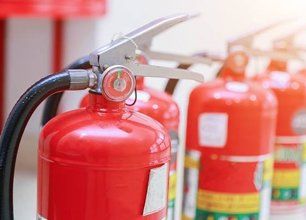Fire Extinguishers
200+ Years' Combined Experience | Quick Turnaround Time | Bundle Discounts Available
200+ Years' Combined ExperienceQuick Turnaround TimeBundle Discounts Available
A Fire Extinguisher Can Stop a Deadly Fire From Spreading
Fire extinguishers are the first line of defense against fires. Our fire extinguisher department can service, install, inspect, and perform all your maintenance needs for all types of fire extinguishers.
Types of fire extinguisher available:
- ABC
- K-class
- Purple K
Different sizes of fire extinguishers that we have:
- 2.5 lbs
- 5 lbs
- 10 lbs
We have CO2 fire extinguishers
available.
Contact any of our two locations, Hattiesburg
and Gulf Coast
to get in touch with the professionals at Southern Fire today!
Halotron I and Halon fire extinguishers
Halotron I
Halotron I is a proven clean fire extinguishing agent designed for streaming applications in portable and handheld fire extinguishers. It is the world's most widely distributed halocarbon-based clean fire extinguishing agent for such applications.
What is Halon and How Does it Work?
Halon
is a liquefied, compressed gas that stops the spread of fire by chemically disrupting combustion. Halon 1211 (a liquid streaming agent) and Halon 1301 (a gaseous flooding agent) leave no residue and are remarkably safe for human exposure. Halon is rated for class "B" (flammable liquids) and "C" (electrical fires), but it is also effective on class "A" (common combustibles) fires. Halon 1211 and Halon 1301 are low-toxicity, chemically stable compounds that, as long as they remain contained in cylinders, are easily recyclable.
Halon
is an extraordinarily effective fire extinguishing agent, even at low concentrations. According to the Halon Alternative Research Corporation: "Three things must come together at the same time to start a fire. The first ingredient is fuel (anything that can burn), the second is oxygen (normal breathing air is ample) and the last is an ignition source (high heat can cause a fire even without a spark or open flame). Traditionally, to stop a fire you need to remove one side of the triangle - the ignition, the fuel or the oxygen. Halon adds a fourth dimension to fire fighting - breaking the chain reaction. It stops the fuel, the ignition and the oxygen from dancing together by chemically reacting with them."
A key benefit of Halon, as a clean agent, is its ability to extinguish fire without the production of residues that could damage the assets being protected. Halon has been used for fire and explosion protection throughout the 20th century, and remains an integral part of the safety plans in many of today's manufacturing, electronic and aviation companies. Halon protects computer and communication rooms throughout the electronics industry; it has numerous military applications on ships, aircraft and tanks and helps ensure safety on all commercial aircraft.
Because Halon
is a CFC, production of new Halon ceased in 1994. There is no cost effective means of safely and effectively disposing of the Halon. Therefore, recycling and reusing the existing supply intelligently and responsibly to protect lives and property is the wisest solution.

Call our Gulf Coast, Hattiesburg, or Semmes location for a FREE estimate on your fire protection service today!
Our staff works very quickly and more efficiently than our competitors in the area.

Share On: